The Twitchell Canyon Fire
High temperatures, dry weather and lightning are a dangerous combination
By Shauna Leavitt
Guest contributor
In late July 2010, the North American monsoon had reached southern Utah. Further south in Arizona and New Mexico, the dependable summer rainy season provides welcome relief from hot, dry weather. In Utah at the edge of the monsoon, the moisture is less predictable, and rain from weak storms often evaporates before it touches the earth. However, even the smallest storms produce one thing strong enough to hit the ground: lightning.
Southwesterners call it "dry lightning," and it is usually accompanied by gusty winds and hot weather: the perfect conditions for wildfire. On July 20, 2010, lightning struck near Twitchell Canyon in the Tushar Mountains of south-central Utah, igniting a landscape where fire had been suppressed for decades.
Southerly winds pushed the fire over the mountaintops, and it burned everything from the spruce-fir forests at the edge of the alpine tundra to the pinyon-juniper grassland near Interstate-70, where fire crews were finally able to gain the upper hand. Three months of flames eventually consumed 45,000 acres of Fishlake National Forest, even attracting the cameras of astronauts aboard the International Space Station.
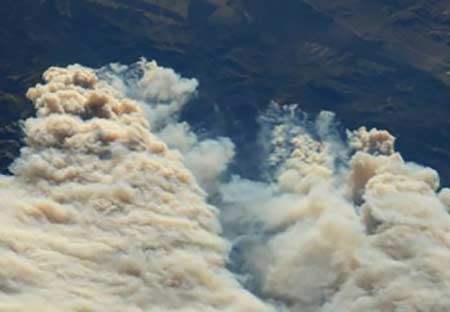
Three months of flames eventually consumed 45,000 acres of Fishlake National Forest, even attracting the cameras of astronauts aboard the International Space Station.
The dramatic scale and intensity of the 2010 Twitchell Fire surpassed any event in living memory, leaving canyons without vegetation and local citizens without their favorite wild places. However, the genetic memory of native plants and animals goes back much further.
One species native to the Tushar Mountains is Utah's state fish, the Bonneville cutthroat trout. Bonneville cutthroat trout are adapted to Utah's dynamic mountain watersheds, and have retained migratory behavior that allows them to find better habitat in the event of drought, fires, floods or other habitat alterations.
When competitive and predatory non-native trout were stocked throughout the state, Bonneville cutthroat trout simply died or went elsewhere, even if that meant passing waterfalls, dams or irrigation diversions that prevent them from ever returning. This behavior explains, in part, why non-native brown, rainbow and brook trout are found statewide, but Bonneville cutthroat trout are limited to less than a third of their historical range, mostly consisting of small headwater streams and heavily managed lakes.
Brown and rainbow trout had likewise displaced Bonneville cutthroat trout from most streams in the Tushar Mountains before the 2010 Twitchell Fire, including Clear Creek and its tributaries within the Sevier River basin. Once ash, gravel and debris started washing into perennial streams, these non-native fishes experienced high mortality. Within one year of the fire, over 90% of the fishes in the burned area were gone, with some tributaries experiencing 100% mortality.
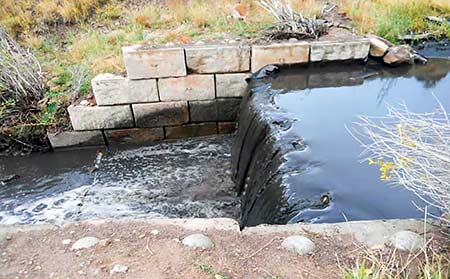
Ash and sediment flowing past a fish barrier on the Clear Creek during a rain storm in 2010 just after the Twitchell Fire was extinguished. Credit: Jim Whelan, US Forest Service.
In addition to starting the fire, monsoon storms completed the fish extirpation by causing catastrophic landslides and debris flows one year later. "The stream fishes within the fire area started to suffocate from ash washing downstream during the first rain event. The rest of the fishes lasted almost a year before the next monsoon season washed entire hillsides into the creek," said Colton Finch, graduate student in Dr. Phaedra Budy's Fish Ecology Lab (Department of Watershed Sciences) at Utah State University (USU). "It wasn't that large of a storm. But when there is nothing stabilizing the hillsides, it doesn't take much to come unzipped," Finch added.
Soon after the fire was out, Utah Division of Wildlife Resources (DWR) began investigating what could be done to restore fish in these remote mountain streams. What appeared to be a devastating fish loss may actually be a conservation boon if the streams could be restored as healthy habitats for the native fish community, including Bonneville cutthroat trout. After installing a fish barrier to keep non-native species out, DWR plans on restocking native species to what is now the largest watershed in Utah without exotic fishes. "The fire is allowing restoration to occur on a scale that would have been difficult or impossible to do by hand. But the probability of success is still unknown because of how much the streams changed after the fire," said Finch.
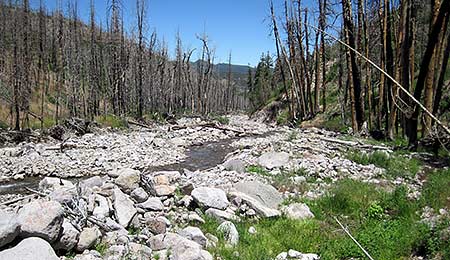
Shingle Creek, a tributary of Clear Creek, after the Twitchell Fire. Photo courtesy of Colton Finch.
To determine if any of the fire-affected streams have recovered enough to support a native trout population and identify priorities for restoration, DWR joined with the research teams of Drs. Patrick Belmont & Phaedra Budy of Department of Watershed Sciences, in the Quinney College of Natural Resources at USU. Finch, is focusing his research on measuring the current quality of fish habitat in the fire-affected streams.
A creek just outside of the burned area likely resembles what burned creeks looked like before the fire. Finch explains, "When I visited the unburned stream I was forced to climb over logs in the stream and duck under fallen trees hanging over the water. There were deep pools of clear water and when we sampled the stream it was boiling with fish."
Finch continues, "When I first visited the burned area it looked like a bulldozer had gone down the middle of the stream. It was completely full of gravel. There were no fish. There were no pools. This was my first taste of what we were dealing with."
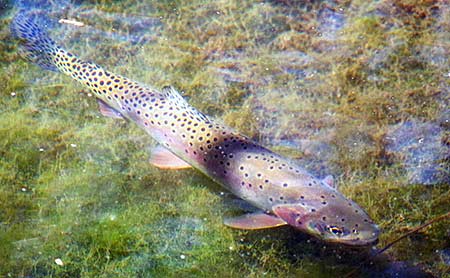
A Bonneville cutthroat trout. Photo courtesy of Colton Finch.
It has been four years since the fire. Most of the burned area is now covered with grasses, wild flowers and sapling oaks and aspens. "When I travel over land I see grouse, mule deer, elk, turkeys, golden eagles and all sorts of small animals. It's a different story underwater," said Finch.
The researchers can see the habitat repairing itself, but the creeks will take the longest to recover. Finch explains, "They are like the drain of a bath tub; all the sediment washed downhill and has collected in streams, and it will take a long time to sort things out."
To determine the quality of fish habitat on burned streams, Finch developed three research areas:
First, he'll identify whether important habitat attributes such as spawning gravel, slow-moving nursery areas, deep pools and cover are available for Bonneville cutthroat trout at 12 index sites. Then he and Keelin Schaffrath, another PhD student from Utah State University, will construct underwater topographic maps and hydraulic models based on a data from a valuable grant awarded by the National Science Foundation.
These data will allow the research team to count and map habitat features at a much larger scale between burned and unburned streams.
Second, Finch will determine if enough food exists in the burned rivers to support a restored population of fish. "I'll be measuring the amount of algae and aquatic insects present in 12 sites in both burned and unburned streams," said Finch. Sterile tiger trout will be stocked in the same undisclosed sites to see how food availability impacts the growth of trout over a two-month study period, as well as to see if the fish prefer different foods depending on whether they live in a burned or unburned stream.
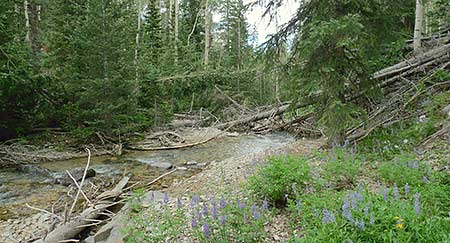
Beaver Creek is an unburned stream adjacent to the Twitchell Fire that provides a reference for how burned streams might otherwise look. Photo courtesy of Colton Finch.
Finally, he will model the potential movement of fish in the Clear Creek watershed to identify features that may block fish migration. Because Bonneville cutthroat trout once lived in the much larger Lake Bonneville and migrated large distances to spawn in rivers like the Provo, Bear, Weber and Sevier, they have a genetic legacy to migrate. Migrating allowed the species to survive when local habitat was temporarily harmed by extreme events like fire by making sure that some individuals were in good habitat elsewhere, and could later return. However, high quality habitats in modern streams and rivers rarely connect to each other, so it is important for Finch to understand how irrigation diversions, fish barriers, waterfalls and stretches of poor habitat affect the ability of fish to cope with the current conditions of streams impacted by the Twitchell Fire.
The results of Finch's research will help local managers discover the best methods for restoring native Bonneville cutthroat trout to fire-impacted streams. It they are successful, the Twitchell fire will have been a serendipitous "ecological reset button", giving managers significant future inroads in native fish conservation and serving as a model for restoration in the increasingly fragmented west.














